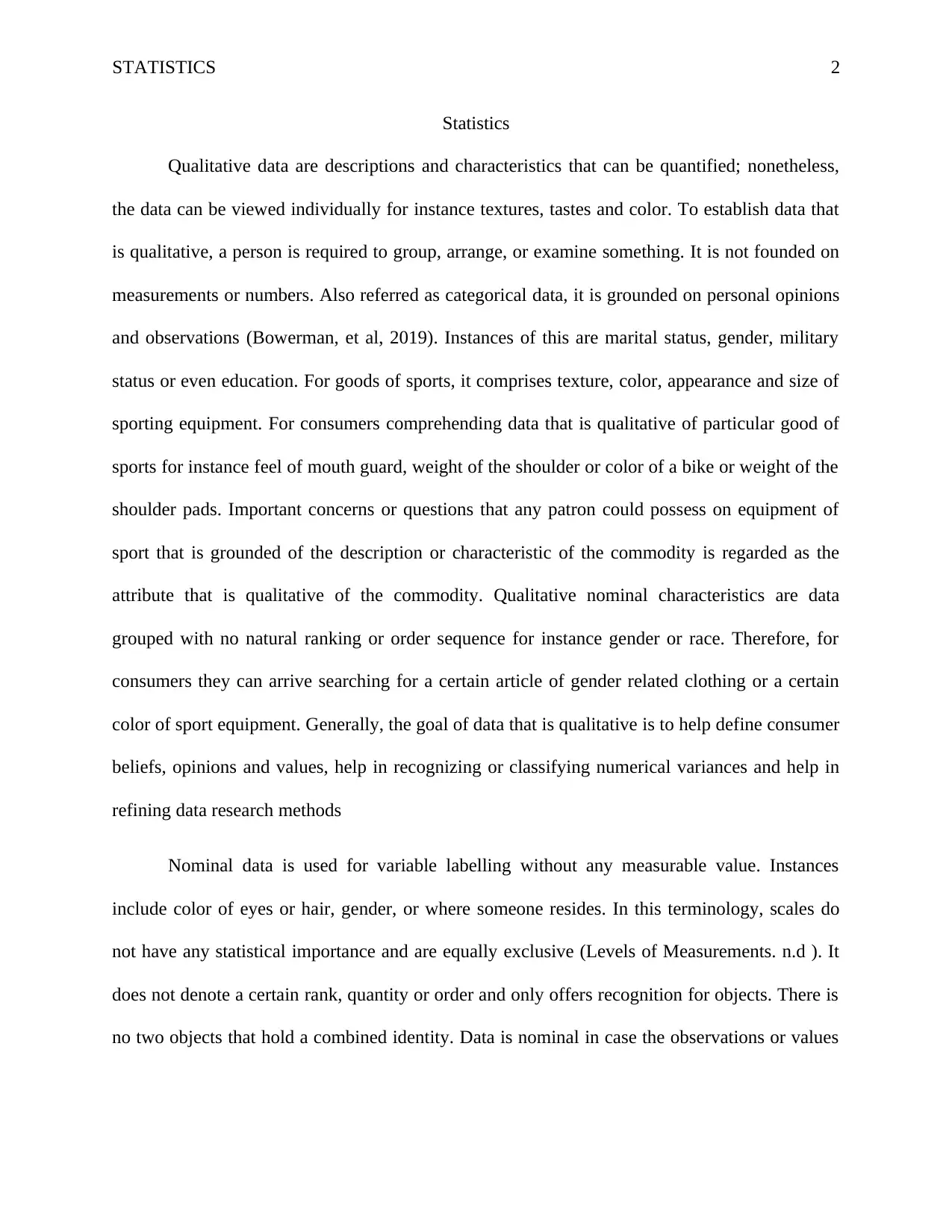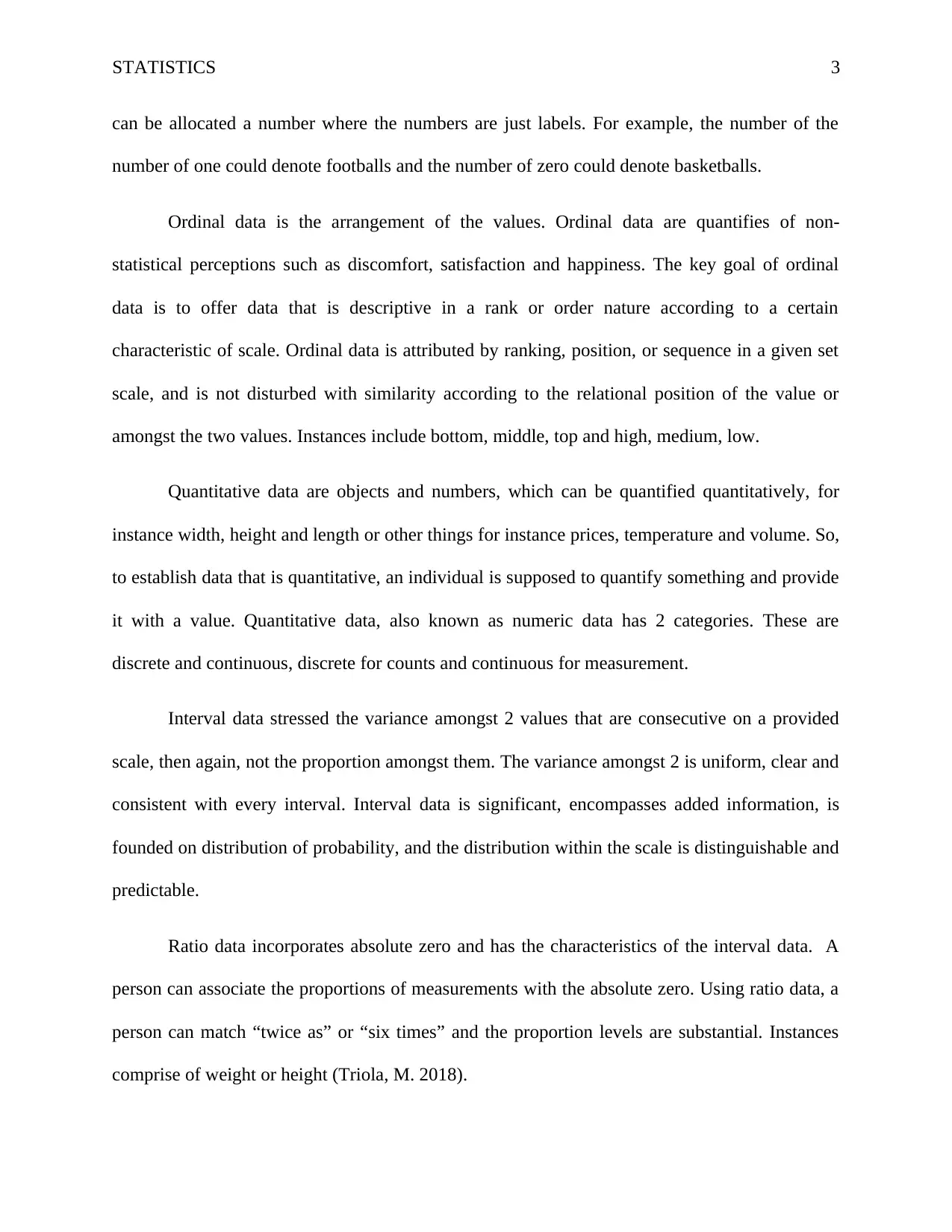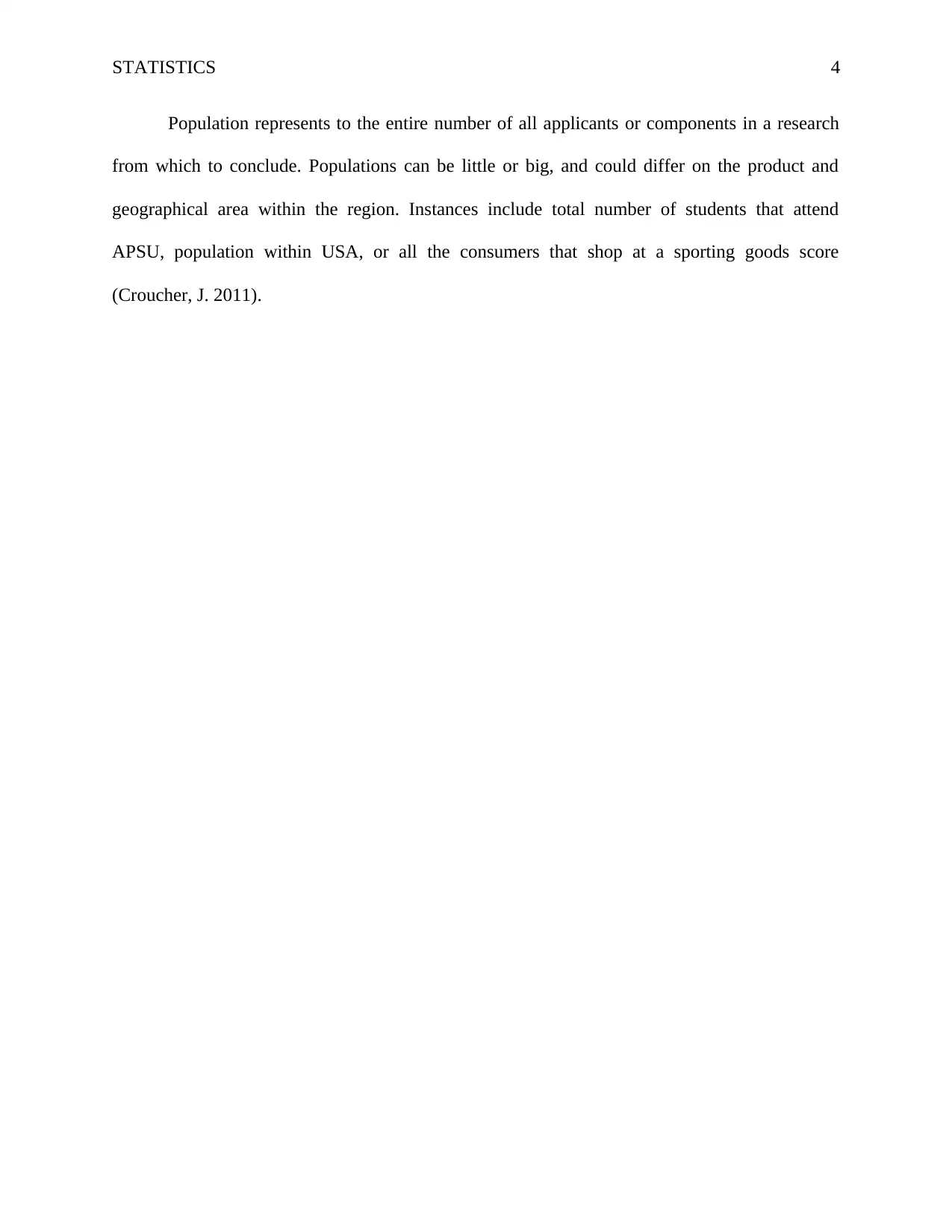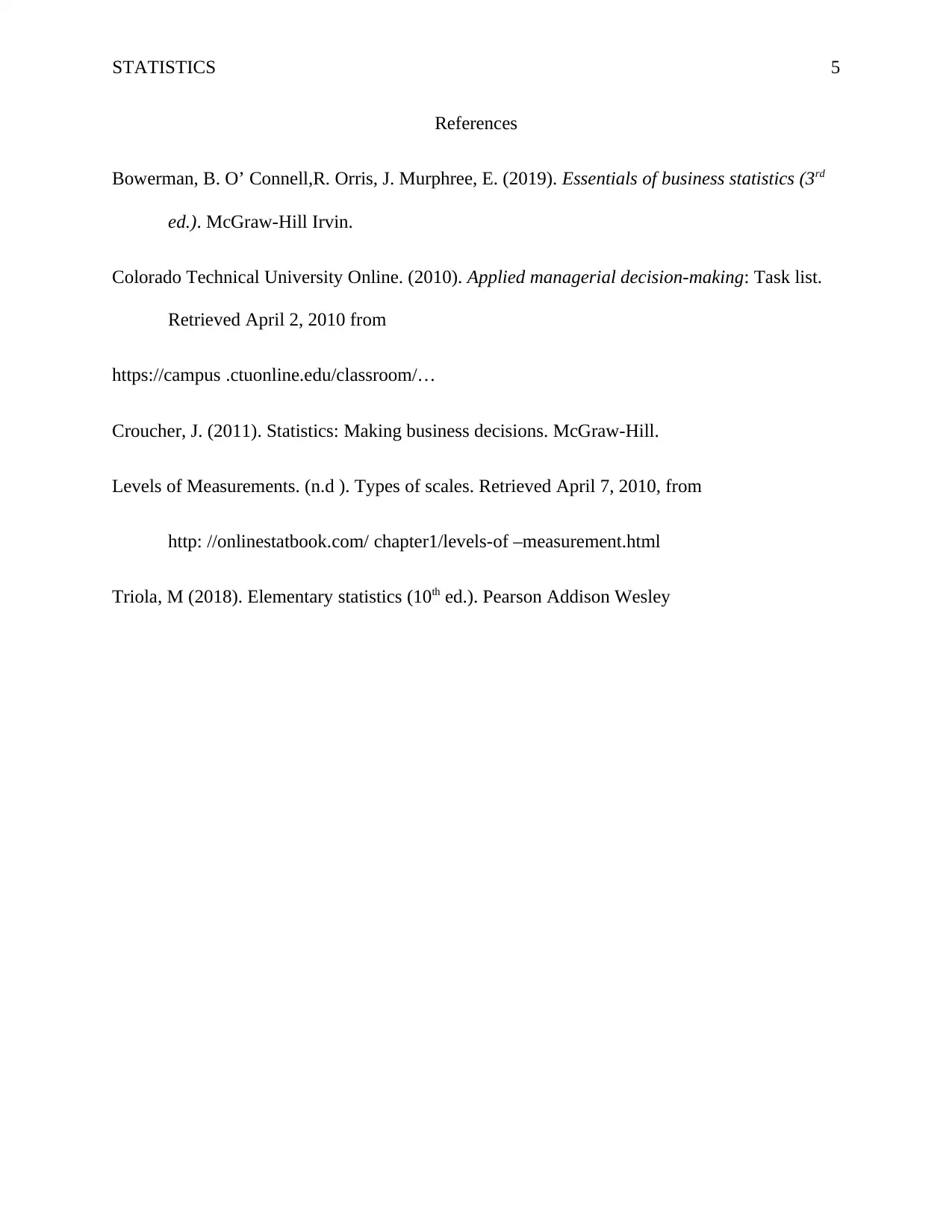Statistics Report: Analyzing Data for Business Decisions, Big D Inc.
VerifiedAdded on 2023/04/23
|5
|898
|440
Report
AI Summary
This report serves as a comprehensive analysis of statistical data, focusing on its application in business decision-making for Big D Incorporated. It begins by defining and differentiating between qualitative and quantitative data, including nominal and ordinal data, and elaborates on their respective characteristics and applications. The report further explores interval and ratio data, emphasizing their significance in statistical analysis. It then addresses the concept of population within the context of research and data interpretation. The report is designed to provide authoritative recommendations to the Board of Directors, interpreting statistical data and making appropriate suggestions based on the data analysis provided.

Running head: STATISTICS 1
Statistics
Name
Institution
Statistics
Name
Institution
Paraphrase This Document
Need a fresh take? Get an instant paraphrase of this document with our AI Paraphraser

STATISTICS 2
Statistics
Qualitative data are descriptions and characteristics that can be quantified; nonetheless,
the data can be viewed individually for instance textures, tastes and color. To establish data that
is qualitative, a person is required to group, arrange, or examine something. It is not founded on
measurements or numbers. Also referred as categorical data, it is grounded on personal opinions
and observations (Bowerman, et al, 2019). Instances of this are marital status, gender, military
status or even education. For goods of sports, it comprises texture, color, appearance and size of
sporting equipment. For consumers comprehending data that is qualitative of particular good of
sports for instance feel of mouth guard, weight of the shoulder or color of a bike or weight of the
shoulder pads. Important concerns or questions that any patron could possess on equipment of
sport that is grounded of the description or characteristic of the commodity is regarded as the
attribute that is qualitative of the commodity. Qualitative nominal characteristics are data
grouped with no natural ranking or order sequence for instance gender or race. Therefore, for
consumers they can arrive searching for a certain article of gender related clothing or a certain
color of sport equipment. Generally, the goal of data that is qualitative is to help define consumer
beliefs, opinions and values, help in recognizing or classifying numerical variances and help in
refining data research methods
Nominal data is used for variable labelling without any measurable value. Instances
include color of eyes or hair, gender, or where someone resides. In this terminology, scales do
not have any statistical importance and are equally exclusive (Levels of Measurements. n.d ). It
does not denote a certain rank, quantity or order and only offers recognition for objects. There is
no two objects that hold a combined identity. Data is nominal in case the observations or values
Statistics
Qualitative data are descriptions and characteristics that can be quantified; nonetheless,
the data can be viewed individually for instance textures, tastes and color. To establish data that
is qualitative, a person is required to group, arrange, or examine something. It is not founded on
measurements or numbers. Also referred as categorical data, it is grounded on personal opinions
and observations (Bowerman, et al, 2019). Instances of this are marital status, gender, military
status or even education. For goods of sports, it comprises texture, color, appearance and size of
sporting equipment. For consumers comprehending data that is qualitative of particular good of
sports for instance feel of mouth guard, weight of the shoulder or color of a bike or weight of the
shoulder pads. Important concerns or questions that any patron could possess on equipment of
sport that is grounded of the description or characteristic of the commodity is regarded as the
attribute that is qualitative of the commodity. Qualitative nominal characteristics are data
grouped with no natural ranking or order sequence for instance gender or race. Therefore, for
consumers they can arrive searching for a certain article of gender related clothing or a certain
color of sport equipment. Generally, the goal of data that is qualitative is to help define consumer
beliefs, opinions and values, help in recognizing or classifying numerical variances and help in
refining data research methods
Nominal data is used for variable labelling without any measurable value. Instances
include color of eyes or hair, gender, or where someone resides. In this terminology, scales do
not have any statistical importance and are equally exclusive (Levels of Measurements. n.d ). It
does not denote a certain rank, quantity or order and only offers recognition for objects. There is
no two objects that hold a combined identity. Data is nominal in case the observations or values

STATISTICS 3
can be allocated a number where the numbers are just labels. For example, the number of the
number of one could denote footballs and the number of zero could denote basketballs.
Ordinal data is the arrangement of the values. Ordinal data are quantifies of non-
statistical perceptions such as discomfort, satisfaction and happiness. The key goal of ordinal
data is to offer data that is descriptive in a rank or order nature according to a certain
characteristic of scale. Ordinal data is attributed by ranking, position, or sequence in a given set
scale, and is not disturbed with similarity according to the relational position of the value or
amongst the two values. Instances include bottom, middle, top and high, medium, low.
Quantitative data are objects and numbers, which can be quantified quantitatively, for
instance width, height and length or other things for instance prices, temperature and volume. So,
to establish data that is quantitative, an individual is supposed to quantify something and provide
it with a value. Quantitative data, also known as numeric data has 2 categories. These are
discrete and continuous, discrete for counts and continuous for measurement.
Interval data stressed the variance amongst 2 values that are consecutive on a provided
scale, then again, not the proportion amongst them. The variance amongst 2 is uniform, clear and
consistent with every interval. Interval data is significant, encompasses added information, is
founded on distribution of probability, and the distribution within the scale is distinguishable and
predictable.
Ratio data incorporates absolute zero and has the characteristics of the interval data. A
person can associate the proportions of measurements with the absolute zero. Using ratio data, a
person can match “twice as” or “six times” and the proportion levels are substantial. Instances
comprise of weight or height (Triola, M. 2018).
can be allocated a number where the numbers are just labels. For example, the number of the
number of one could denote footballs and the number of zero could denote basketballs.
Ordinal data is the arrangement of the values. Ordinal data are quantifies of non-
statistical perceptions such as discomfort, satisfaction and happiness. The key goal of ordinal
data is to offer data that is descriptive in a rank or order nature according to a certain
characteristic of scale. Ordinal data is attributed by ranking, position, or sequence in a given set
scale, and is not disturbed with similarity according to the relational position of the value or
amongst the two values. Instances include bottom, middle, top and high, medium, low.
Quantitative data are objects and numbers, which can be quantified quantitatively, for
instance width, height and length or other things for instance prices, temperature and volume. So,
to establish data that is quantitative, an individual is supposed to quantify something and provide
it with a value. Quantitative data, also known as numeric data has 2 categories. These are
discrete and continuous, discrete for counts and continuous for measurement.
Interval data stressed the variance amongst 2 values that are consecutive on a provided
scale, then again, not the proportion amongst them. The variance amongst 2 is uniform, clear and
consistent with every interval. Interval data is significant, encompasses added information, is
founded on distribution of probability, and the distribution within the scale is distinguishable and
predictable.
Ratio data incorporates absolute zero and has the characteristics of the interval data. A
person can associate the proportions of measurements with the absolute zero. Using ratio data, a
person can match “twice as” or “six times” and the proportion levels are substantial. Instances
comprise of weight or height (Triola, M. 2018).
⊘ This is a preview!⊘
Do you want full access?
Subscribe today to unlock all pages.

Trusted by 1+ million students worldwide

STATISTICS 4
Population represents to the entire number of all applicants or components in a research
from which to conclude. Populations can be little or big, and could differ on the product and
geographical area within the region. Instances include total number of students that attend
APSU, population within USA, or all the consumers that shop at a sporting goods score
(Croucher, J. 2011).
Population represents to the entire number of all applicants or components in a research
from which to conclude. Populations can be little or big, and could differ on the product and
geographical area within the region. Instances include total number of students that attend
APSU, population within USA, or all the consumers that shop at a sporting goods score
(Croucher, J. 2011).
Paraphrase This Document
Need a fresh take? Get an instant paraphrase of this document with our AI Paraphraser

STATISTICS 5
References
Bowerman, B. O’ Connell,R. Orris, J. Murphree, E. (2019). Essentials of business statistics (3rd
ed.). McGraw-Hill Irvin.
Colorado Technical University Online. (2010). Applied managerial decision-making: Task list.
Retrieved April 2, 2010 from
https://campus .ctuonline.edu/classroom/…
Croucher, J. (2011). Statistics: Making business decisions. McGraw-Hill.
Levels of Measurements. (n.d ). Types of scales. Retrieved April 7, 2010, from
http: //onlinestatbook.com/ chapter1/levels-of –measurement.html
Triola, M (2018). Elementary statistics (10th ed.). Pearson Addison Wesley
References
Bowerman, B. O’ Connell,R. Orris, J. Murphree, E. (2019). Essentials of business statistics (3rd
ed.). McGraw-Hill Irvin.
Colorado Technical University Online. (2010). Applied managerial decision-making: Task list.
Retrieved April 2, 2010 from
https://campus .ctuonline.edu/classroom/…
Croucher, J. (2011). Statistics: Making business decisions. McGraw-Hill.
Levels of Measurements. (n.d ). Types of scales. Retrieved April 7, 2010, from
http: //onlinestatbook.com/ chapter1/levels-of –measurement.html
Triola, M (2018). Elementary statistics (10th ed.). Pearson Addison Wesley
1 out of 5
Related Documents
Your All-in-One AI-Powered Toolkit for Academic Success.
+13062052269
info@desklib.com
Available 24*7 on WhatsApp / Email
![[object Object]](/_next/static/media/star-bottom.7253800d.svg)
Unlock your academic potential
Copyright © 2020–2025 A2Z Services. All Rights Reserved. Developed and managed by ZUCOL.




